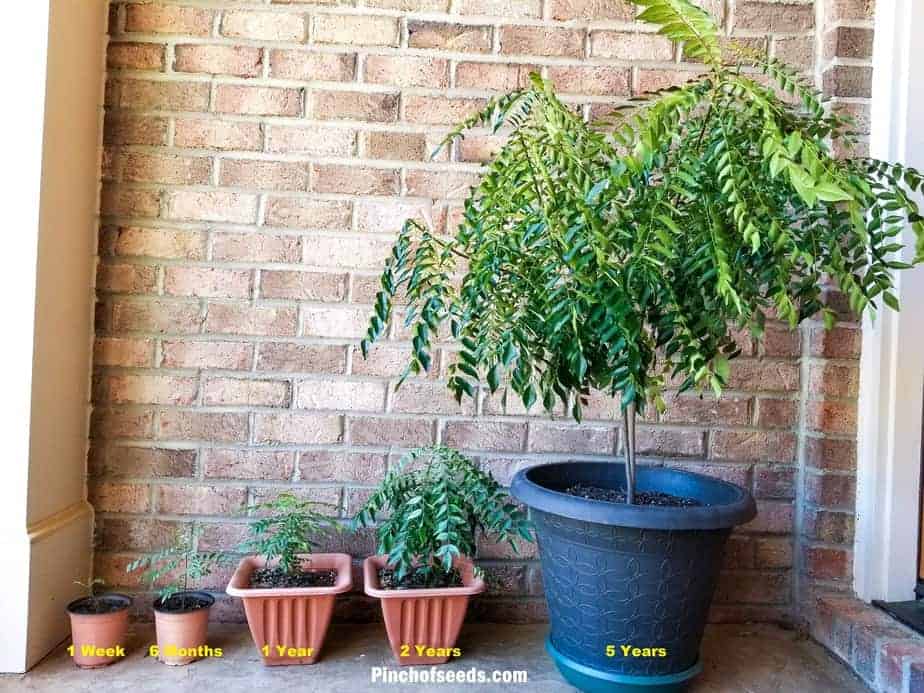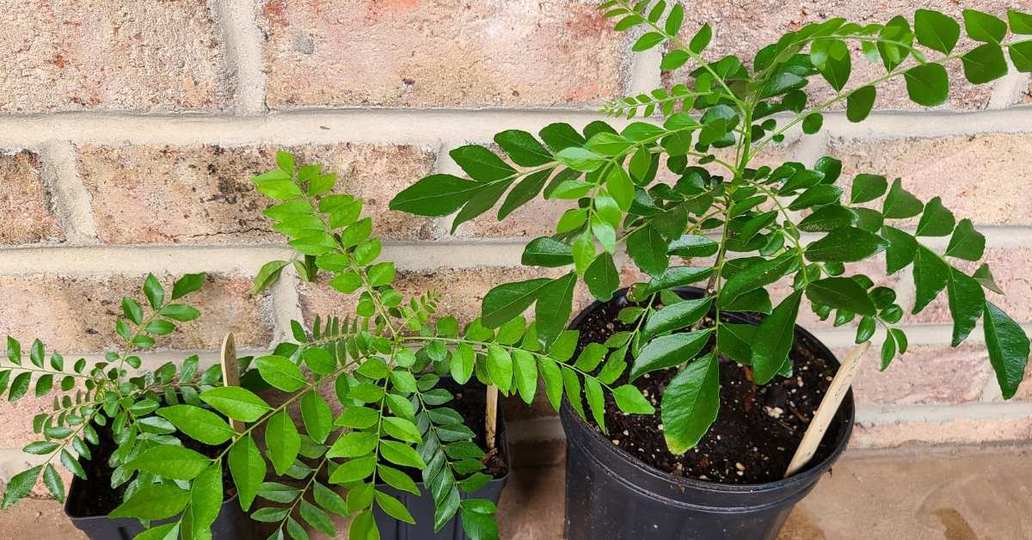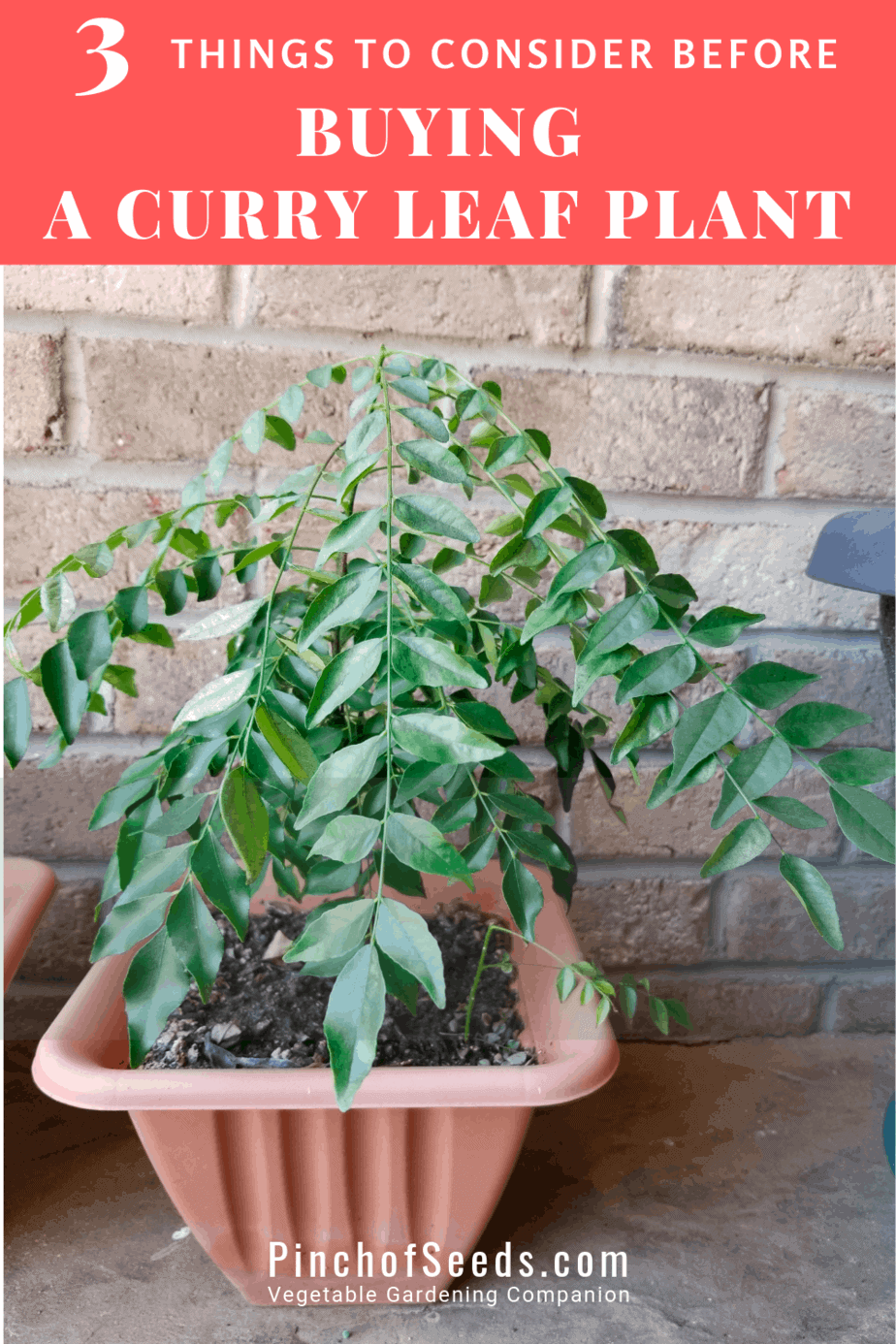The Curry Leaf plant is one of the most essential herbs for any Indian kitchen garden. It is also known as curry leaves plant, curry leaf tree, or curry patta plant. Every spring, my two fully grown curry leaf trees produce several short side- shoots near the base of the plants, a.k.a. Baby Curry leaves plants. Last year, I posted Indian Curry leaf plants for sale on my Facebook page, asking if anyone was interested in buying. An overwhelmingly large number of people responded with interest in buying a curry leaf plant.
When I started chatting with people interested in buying, I realized most had not raised a curry leaves plant before. They had big expectations from a baby plant.
They were under the impression that:
- Once you get a curry leaf plant, you will not have to buy curry leaves from the Indian grocery store.
- The curry leaf plant will provide large, glossy, green curry leaves for everyday cooking in a few short days.
- All you have to do is get a curry leaf plant, plant it in the garden or a pot and you are all set!
If you believe in any one of the above, you are seriously in for a big surprise! See the video below.
Before we dig deep, let me just summarize what a curry leaf tree is:
The curry leaf is a small evergreen tree that originates from India. In India, the curry leaf tree is also known as sweet neem, Kadi Patta, Mitho Limdo, or karuveppilai.
The curry leaf tree thrives in tropical to sub-tropical weather and is native to India and Sri Lanka. Therefore, technically it should be called a curry leaf tree, not a curry leaf plant. The curry leaf tree grows to a height of 10-15 feet. When the plant matures, it produces small, white flowers which turn into seeds. The curry leaves are fragrant, dark green with a glossy texture.
Curry leaves are one of the must-have ingredients in Indian cooking. The curry leaves are a flavoring agent in many Indian curries, lentil dishes, chutneys, and soups. The curry leaves have a pungent, slightly bitter taste and are used fresh or dried.
Curry leaves are also used in Ayurvedic medicine and are believed to have various health benefits. For example, curry leaves are rich in antioxidants and vitamins A, B, and C. They also contain compounds that may help lower cholesterol and blood sugar levels. In addition, curry leaves are said to boost digestive health and promote weight loss. While more research is needed to confirm these claims, there is no doubt that curry leaves are a healthy addition to Indian cuisine.
If you want to grow this amazingly aromatic plant, there are some things you should know to set your expectations right. Here are the five facts you must know and consider before you buy a curry leaf plant:
1. How much sunlight does a curry leaf plant need?
Curry leaves plant grows best in about 6 to 8 hours of direct sunlight. Therefore, make sure the area where you want to place the plant has good airflow and direct sunlight for most of the day. During the hot months of summer, the curry leaf plant should be moved to the part sun area.
If the plant does not get enough sunlight, it will not grow properly. Without enough light, the plant will not be able to produce enough food to survive. As a result, the curry leaves may turn pale yellow or fall off the plant. Additionally, the leaves loses the aroma and may become thin and pointy.
Does that mean you can’t grow a curry leaf plant if you live in an apartment or your balcony does not get 6 hours of sun? No, not necessarily. If you plan to keep the curry leaves plant indoors, consider investing in good indoor grow light. Your curry leaf plant will be happy and thriving indoors!
2. Can a curry leaf plant survive freezing weather?
Curry leaf plant is native to the place where most of the year stays warm and humid. The Curry leaf plant does not like the cold season and cannot survive freezing temperatures. If you live in an area where the winter temperature dips below 32 degrees F, you should not plant the curry leaf plant in the ground in your garden. For that reason, it is best to plant the curry leaf plant in a container or a pot that you can bring inside the house or store in the garage for the winter months.
When stored in a garage with no direct sunlight during the winter months, the plant may lose most leaves. That’s okay! If you continue to lightly water the curry leaf plant every 7-10 days, it will come back to life once you put it outside in the spring.
I keep my curry leaf plants inside my house during cold months, near a large window that receives sunlight almost all day long. The plants seem to like the coziness of the space! They stay green and even put out new growth and new baby plants during the winter months! I spray the plant with a DIY natural pesticide made with neem oil to protect it from scale, spider mites, and fungus gnat attacks while indoors.
Consider your current residence and the space for the curry leaf plant during colder months before you buy a new plant.
A young curry leaf plant doesn’t require much space, but at 4 years of age, it will be 4 to 5 feet tall and a 3 to 4 feet wide Curry Leaf tree! As the plant grows older, it will need more space. Do you have enough space inside the house or apartment to store the plant for the long term? Will there be any pet that will cause harm to the curry leaf plant while inside?
3. How fast does a curry leaf plant grow?
Have you ever wondered why the baby curry leaf plant costs more than other plants like peppers and tomatoes? Or if you have a Curry Leaf Plant and wonder, ‘Why is my curry leaf plant not growing?’.
Curry Leaf plant is actually a shrub (small tree) that grows slowly. Therefore, the Curry leaf plant is not a fast grower in the initial stage. It takes a couple of years for the young curry leaf plant to establish roots and adjust to the new environment before it starts to grow in height.
Here is the picture of my curry leaf plants at various ages, including one 5-year old Curry Leaf Tree. Please keep in mind that your area’s weather and growing conditions may produce different results than mine.

Visual comparison of curry leaf plant growth: From left to right-
The first one is a 1-week old seedling. It is 4″ tall and 3″ wide in the spread. It’s been recently cut out from the mother plant.
The second one is a 6-month-old seedling. The plant height is 6,” and the width is 6″. The leaflets are small and spaced out far apart.
The Third one is a 1-year-old plant. The plant height is 7,” and the width is 8″.
The fourth one is an almost 2 years old plant. The height is 12,” and the width is 13″. It took this plant a year to grow a couple of inches! The leaves are nicely dense, greener, and more prominent than the previous plants.
The fifth one is an almost 5 years old plant. The height is 3 ft (because I kept pruning the curry leaf plant to maintain the size), and the width is 3.5 ft. I harvest roughly 10 to 15 leaflets (the entire string of small leaves) every 15 days from this curry leaf plant.
As you can see from the picture and the description above, the curry leaf plant takes time to establish and grow tall in the earlier stage of life. However, once the plant is 2 to 3 years old, it will be taller, denser, and ready to be harvested.
Before buying a curry leaf plant, consider how long you can wait and babysit the plant before you want to start harvesting the leaves.
If you have the patience to wait for a couple of years before harvesting the leaves, buy a small curry leaf plant here, which is usually cheaper.
If going to the grocery store every week to get the curry leaves is too much for you, and you can invest little extra upfront, buy the largest curry leaf plant you can afford. You will reap the rewards months, if not years, earlier.
Will the Curry leaf plant grow more leaves if I harvest a few?
Curry leaf tree grows new leaves on the tips of the branch only. That means, no new leaves will grow in place of where the old leaves were harvested from. Therefore, to make the curry leaf plant grow more leaves, the plant needs to have more branches. For this reason, pruning (cutting off) a plant regularly and correctly is essential. See this step-by-step guide for pruning a curry leaf plant.
Once you buy a curry leaf plant from online sources or through an Indian grocery store near you, here is a guide about caring for your curry leaf plant, transplanting a curry leaf plant, and fertilizing a curry leaf plant to make it greener and grow faster.

Conclusion:
Before buying a curry leaf plant, you should consider a few things. First, make sure you have enough space for a fully grown Curry Leaf tree before buying, as they can get quite large. Provide at least 6 hours of sunlight and be patient. Also, be aware that Curry Leaf trees require a fair amount of care and attention – if you’re not prepared to put in the work, it’s probably best to look elsewhere. With all that being said, owning a Curry Leaf plant can be incredibly rewarding – so if you think you’re up for the challenge, go ahead and make your purchase!
I hope I have provided you with enough information to make an informed decision when buying a curry leaf plant. If you still have any questions or concerns about buying or growing a curry leaf plant, feel free to leave a comment below, and I will respond soon.
The secret of growing lush green curry leaf plant:
So many of the readers of this article have reached out to me asking how do I get my Curry Leaf tree so lush and green. So here’s the secret of my success: I regularly apply liquid fertilizer to all my curry leaf plants monthly from spring to late summer. The one I use the most is this organic liquid fertilizer. I not only use it to fertilize curry leaf plants but also use it to fertilize vegetable and flower seedlings. I also amend the potting soil with blood meal at the beginning of the season and when re-potting the curry leaf plant.
Want to know more about growing a Curry Leaf Plant?
- How to care for a Curry Leaf Plant
- How to Transplant a Curry Leaf Plant
- Best Fertilizers For Curry Leaf Plant- Natural and Organic Options
- How to prune a curry leaf plant to make it bushy
Ask your questions:
Please comment below if you have any questions about growing curry leaf plants. Or connect with me on the Pinch of seeds group on Facebook. You can ask questions, post a picture for photo consultation, get a personalized response and interact with other gardeners. See you there!
Last Updated: 31/3/2022



Thank you for all of the information on the Curry Leaf. I live in zone 9 (Houston) and just bought a maybe two yr/old (aging by your photo scale). My plant started showing tan/brown spots on the bottom half of the leaf tops. Top half of the plant is still a beautiful green. Am I watering to much. I water it daily. It’s outside in a pot. It’s in direct sun for about 4-6 hrs then spoty for the rest of the day. Any help would be awesome.
Hi Gopi,
Great information about curry leaf planting and fertilizing. I got a 3 weeks old plant in a small pot and keeping it near the kitchen window. It currently has 4-5 leaflets. Watering once in 2-3 days. Do I need to add blood meal or any other fertilizer at this point or should I wait until it grows a little more? Also, do I need to re-pot it now or when is the best time to do that? Thanks so much for sharing your insights.
Hi Jyothi,
It would be better to let it grow at least 6″ to 8″ tall with many leaflets, before adding any fertilizer. If you wish, you can give it a mild buttermilk mixture every 15 days or so.
I would cut back on the watering though! Since the plant is small and inside the house, it won’t need watering every 2-3 days. Let the soil dry out a bit in between the watering. The soil should feel dry when scratched.
The small curry leaf plants are very susceptible to root rot, and watering too much is one of the most common way to kill the plant.
Best wishes,
Gopi
Hi Gopi,
Thanks for your prompt response and the tips. I will get back if there’s anything else.
Dear Gopi,
Thank you very much for your informative article, it is difficult find information on these plants.
We have about 10 small seedlings growing presently but some are double from the same seed.
Would it be wise to split them into 2 plants or allow to grow as is?
Your input would be appreciated
Dave
Hi Dave,
I am glad you find the information helpful!
How tall are the baby plants? I would leave them as-is until they are 8″ to 10″ tall. This will give them enough time to grow their own roots. So when you split them, there are more chances that they will survive.
– Gopi
Hi, Gopi,
Thanks for sharing this helpful information. I have a 1 year old curry leaf plant that seems to match with your 1 year old in your picture. I was curious if you top the plant to encourage branching at some point to get the more bushy 5 year results or if you let the tree grow from a single trunk?
Thanks,
Dan
Hi Dan,
Yes, I cut the top of the plant when the plant reaches 8 to 12 inches of height. That will make the plant split and shoot out two branches. Then again, I cut the branches when they grow about 12″. I continue doing this to keep the plant shorter and well branched. More branches will produce more leaves.
Hope this helps! Let me know if you have any other question.
– Gopi
Thanks for the response! I’m really looking forward to seeing my tree grow over the coming years and appreciate your help. 🙂
You’re welcome!
You might be interested in checking out the post How to plant Curry Leaf Plant, in which I showed how I gradually provide bigger pot for curry leaf plant. It has tips on fertilizing the curry leaf plant as well.
Hi,
My curry leaf plant is sprouting two small babies. Are they transplantable? If yes at what size should
I transplant them?
thanks
Marcella
Hi Marcella,
The baby plants can be transplanted in to separate pots when they are about 6″ tall or have 5 to 6 sets of leaflets. This gives then enough time to grow the roots they will need to survive on their own.
Hope this helps!
Gopi
Thank you for all your very helpful information
I knew nothing about the curry tree,
Now I can go and buy on in full confidence
Thanks again
Thank you for your comment. I am glad you find the information helpful.
I have a small curry leaf plant . do they need direct sunlight? as my balcony faces the south & i never get any direct sunlight
Curry leaf plant grows best with 6 to 8 hours of direct sunlight. But my curry leaf plants survive the cold winter weather inside the house without any direct sunlight. They don’t grow much during that time though.
Hi Gopi,
I have a curry plant indoors. The plant gets direct sunlight for more than 5 hours a day but is indoors. I see that the leaves are falling off and dry. It is hot summer months and over 80 degrees so I don’t think it should be going dormant. What am I doing wrong.
Purvi
Hi Gopi Thank you for all that information. So can I buy a curry plant from you? Where are you? I am in Qld Brisbane north Thank you Lois
Sorry, I can not ship curry leaf plant at this time.
Gopi, thank you for your very informative post about raising a curry leaf plant. Do you happen to have any for sale at this time ? Would need it to be shipped to Texas.
Good info. Thanks Gopi.
Do you have any seeds/saplings you can ship to Los Angeles?
I have been taking my all my curry plant pots in the garage for last 10 years now during winter season. They do much better inside the garage than the house. they stay fresh and i don’t see many leaves fall down. I believe taking them inside kills my plant faster as the leaves wither off during to heat in the house.
I try taking them out once in a while when the temp is above 55 Fahrenheit for just an hour or so. And very little water is required in winters as they don’t grow then. Just for survival purpose I do water them a little in a week or 10 days.
Hope this helps.
Very informative Gopi…thanks for the posting, and I thought I knew more about curry leaf plant as I am from Kerala and we have these in the yard like big trees…but I could not raise a single one for more than a season and they die…this is good, I am going to try to save my plants.
Hi,how many days it will take to transform from flower to seed stage.
Thanks
In my weather in Zone 7, it takes about 6 months to transform flower to seeds, and then another 2-3 months to turn those seeds in to mature seeds that can be replanted.
– Gopi
Are you selling curry plant or seeds